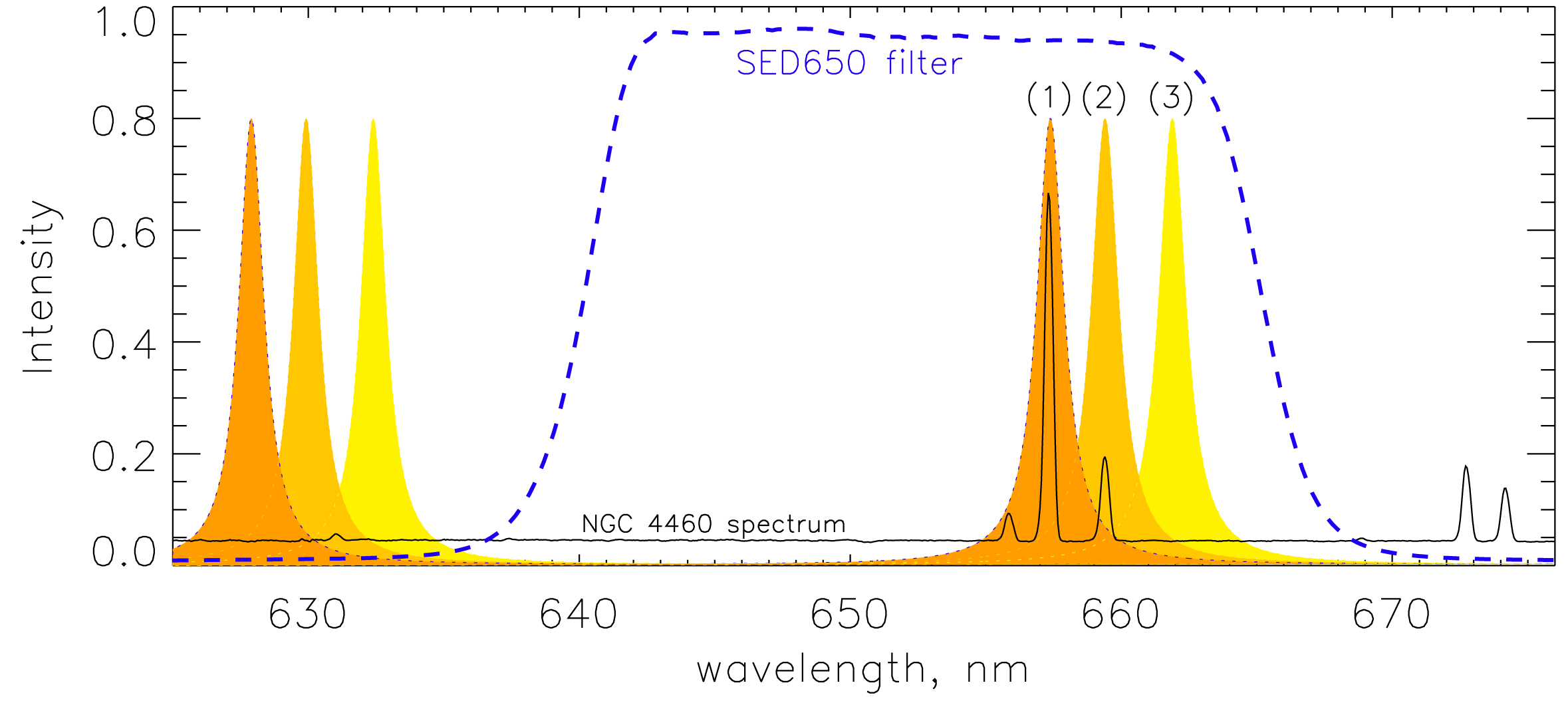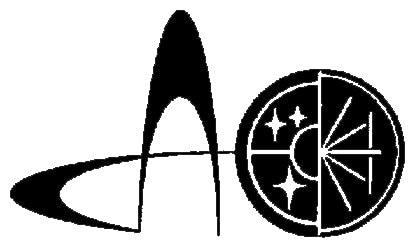MaNGaL
A description of the mechanical and optical design and details on the on-sky commissioning runs made on both telescopes (1-m Zeiss SAO RAS and 2.5-m KGO SAI MSU) are provided in Moiseev et al, 2020
Main parameters of MaNGaL at the SAO RAS and SAI MSU telescopes
| 1-m SAO RAS (Cassegrain, F/13) |
2.5-m SAI MSU (Nasmyth-2, F/8) |
|
|---|---|---|
| Total focal ratio: | F/5.26 | F/3.25 |
| IFP: | ET-50 IC Optical Systems Ltd | |
| Reducer: | 1:2.2 | |
| Field of view: | 11.8′ | 5.6′ |
| Pixel scale: | 0.90′′ | 0.33′′ |
| Spectral range: | 460–750 nm | |
| Spectral resolution: | 1.0–1.5 nm | |
| CCD: | TK1024 1024×1024 24×24 μm |
Andor iKon-M 934 1024×1024 13×13 μm |
| Medium-band filters: | Edmund optics, FWHM = 10 - 25 nm, peak transmission ~ 95% | |
Basic idea
Tunable filter (TF) imaging systems based on low-order scanning Fabry-Perot interferometers (FPIs) have a long history of astronomical applications related to the study of extended emission-line targets: galactic and extragalactic nebulae, solar system objects. The main idea of observations are illustrated in the next Figure. If the gap between FPI plates is small and corresponds to the interference orders n = 10−30, then it is easy to attain the FWHM of the instrumental profile δλ = 1−2 nm. Since the distance between neighbouring interference orders (interfringe) δλ = λ/n, we can cut the desired transmission peaks by the medium-band filter with a typical bandwidth of about 15–30 nm. The peak transmission central wavelength (CWL) can be switched between the desired emission line and neighboring continuum using a piezoelectrically-tuned and servo-stabilized FPI; the redshift/systemic velocity of the studied objects can be taken into account.

Optical scheme
The instrument optical scheme consists of a two-component achromatic field lens and a six-component anastigmatic photographic lens ‘Helios-44M-7’ (F/2). In contrast to the ‘classical’ optical layout having a TF in the collimated beam, MaNGaL is an afocal reducer with the FPI in the convergent beam as was proposed by Courtes. This arrangement provides a significantly larger size of a central monochromatic regions that is crucial in studying the extended targets.

Filters
We use hard coated bandpass filters also produced by Edmund Optics. The main set of the filters with the 25-nm bandwidth is similar to that described in Dodonov et al., 2017. These filters uniformly cover the 460–750-nm wavelength interval, their trans- mission curve has an almost rectangular shape with a maximum throughput of ~ 95%. Also, we use several filters with the 10-nm bandwidth which cover the spectral regions between the 25-nm filter profiles.
Papers based on MaNGaL observations
This list in NASA ADS- The Nature of S0 Galaxies: an Unusual Case of the Isolated Lenticular Galaxy NGC 6798—a Gas Reservoir without Accretion
Sil'chenko, O. K., Moiseev, A. V., Oparin, D. V., Smirnova, A. A., Maleeva, E. A., & Silchenko, A. V.
2025AstBu..80....1S - Star Formation in the Lopsided Galaxy Arp 291
Proshina, I. S., & Oparin, D. V.
2025ApJ...980..118P - Parameters of Star Formation Regions in Galaxies NGC 3963 and NGC 7292
Gusev A. S., Sakhibov F. Kh., Moiseev A. V., Kostiuk V. S., Oparin D.V.
2024ARep...68..619G - The TELPERION survey for extended emission regions around active galactic nuclei: a strongly interacting and merging galaxy sample
Keel, W. C., Moiseev, A., Uklein, R., & Smirnova, A.
2024MNRAS.530.1624K - Nature of the diffuse emission sources in the H I supershell in the galaxy IC 1613
Yarovova, A. D., Moiseev, A. V., Gerasimov, I. S., Vučetić, M. M., Egorov, O. V., Ilić, D., Mereminskiy, I. A., Pakhomov, Y. V., & Sholukhova, O. N.
2024MNRAS.529.4930Y - Star formation in outer rings of S0 galaxies. VI. NGC 1211: Bar resonance versus accretion
Tsvetkov, N., Moiseev, A., Sil'chenko, O., Katkov, I., Oparin, D., Uklein, R., & Smirnova, A.
2024A&A...682L..16T - 3D structure of H II regions in the star-forming complex S254-S258
Kirsanova, M. S., Moiseev, A. V., & Boley, P. A.
2023MNRAS.526.5187K - Enigmatic Emission Structure around Mrk 783: Cross-Ionization of a Companion 100 kpc Away
Moiseev, A. V., Smirnova, A. A., & Movsessian, T. A.
2023Univ....9..493M - Star Formation in Lenticular Galaxies with MaNGaL Mapper
Sil'chenko, O. K., Moiseev, A. V., Oparin, D. V., Maleeva, E. A., & Proshina, I. S.
2023AstBu..78..304S - Counter-Rotating Gaseous Disk and Star Formation in the S0 Galaxy NGC 934
Sil'chenko, O. K., Moiseev, A. V., Oparin, D. V., Zlydneva, D. V., & Kozlova, D. V.
2023AstL...49..229S - Star formation in outer rings of S0 galaxies. V. UGC 4599: An S0 with gas probably accreted from a filament
Sil'chenko, O., Moiseev, A., Oparin, D., Beckman, J. E., & Font, J.
2023A&A...669L..10S - Stellar feedback impact on the ionized gas kinematics in the dwarf galaxy Sextans A
Gerasimov, I. S., Egorov, O. V., Lozinskaya, T. A., Moiseev, A. V., & Oparin, D. V.
2022MNRAS.517.4968G - Young Star-Forming Complexes in the Ring of the S0 Galaxy NGC 4324
Proshina, I. S., Moiseev, A. V., & Sil'chenko, O. K.
2022AstL...48..139P - Star formation in the elliptical (?) galaxy NGC5173
Sil'chenko O. K., Proshina I. S., Moiseev A. V., Oparin D. V.
2022AstBu..77...40S; Russian PDF - The TELPERION survey for distant [O III] clouds around luminous and hibernating AGN
Keel W.C., Moiseev A., Kozlova D.V., Ikhsanova A.I., Oparin D.V., Uklein R.I., Smirnova A.A., Eselevich M. V.
2022MNRAS.510.4608K - Medium-band photometric reverberation mapping of AGNs at 0.1 < z < 0.8. Techniques and sample
Malygin, E.; Uklein, R.; Shablovinskaya, E.; Grokhovskaya, A.; Perepelitsyn, A.
2020CoSka..50..328M - Extended gaseous disk in S0 galaxy NGC 4143
Sil'chenko O.K., Moiseev A.V., Oparin D.V.
2020AstL...46..289S - Ionized gas in the galaxy NGC 3077
Oparin D.V., Egorov O.V., Moiseev A.V.
2020AstBu..75..361O; Russian PDF - Measurement of the supermassive black hole masses in two active galactic nuclei by the photometric reverberation mapping method
Malygin, E. A.; Shablovinskaya, E. S.; Uklein, R. I.; Grokhovskaya, A. A.
2020AstL...46..726M - 3D structure of the H II region Sh2-235 from tunable-filter optical observations
Kirsanova, M. S.; Boley, P. A.; Moiseev, A. V.; Wiebe, D. S.; Uklein, R. I.
2020MNRAS.497.1050K - Mapper of Narrow Galaxy Lines (MaNGaL): new tunable filter imager for Caucasian telescopes
Moiseev, A. V.; Perepelitsyn, A. E.; Oparin, D. V.
2020ExA....50..199M - Photometric Reverberation Mapping of AGNs at 0.1 < z < 0.8. I. Observational Technique
Uklein, R. I.; Malygin, E. A.; Shablovinskaya, E. S.; Perepelitsyn, A. E.; Grokhovskaya, A. A.
2019AstBu..74..388U - AGN photoionization of gas in companion galaxies as a probe of AGN radiation in time and direction
Keel, William C.; Bennert, Vardha N.; Pancoast, Anna; Harris, Chelsea E.; Nierenberg, Anna; Chojnowski, S. Drew; Moiseev, Alexei V.; Oparin, Dmitry V.; Lintott, Chris J.; Schawinski, Kevin; Mitchell, Graham; Cornen, Claude
2019MNRAS.483.4847K
Confernce posters
- "Kinematics and ionization properties of gas outflows in
nearby galaxies viewed with Fabry-Perot interferometry."
Alexei Moiseev, Dmitry Oparin, Aleksander Perepelitsin & William C. Keel
15th Potsdam Thinkshop
“The role of feedback in galaxy formation from small-scale winds to large-scale outflows”, Potsdam, Germany.
The poster in pdf format

